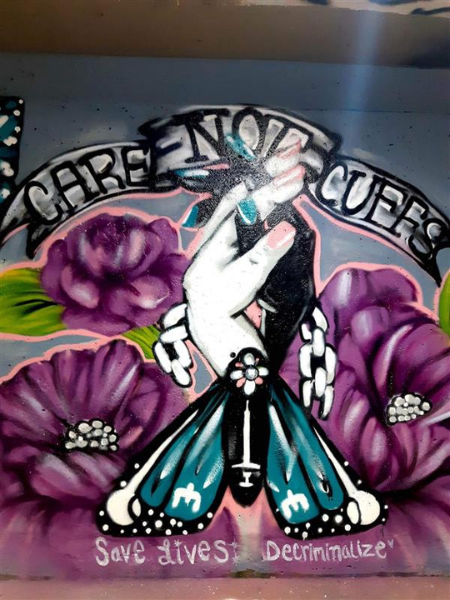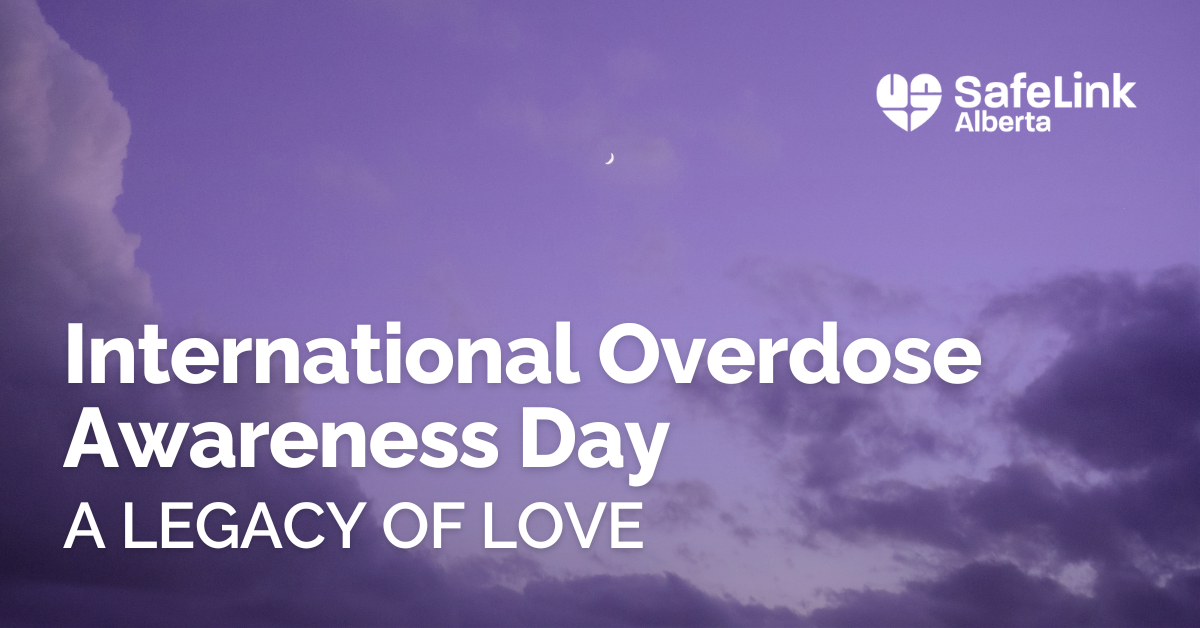This blog was written by Alexandra Ewanyshyn (she/her), Systems Navigator, SafeLink Alberta. Editing by Oluwaseun Ayodeji Osowobi and Alisha Ostberg.
Table of Contents
What is International Overdose Awareness Day?
International Overdose Awareness Day (IOAD) began in Melbourne, Australia, in 2001. Started by S.J. Finn, a family therapist working as the manager of The Salvation Army St Kilda Needle and Syringe Program, Finn had recognized a need to address the resounding grief their community was experiencing. IOAD was born out of a community’s goal to “end overdose, remember without stigma those who have died, and acknowledge the grief of the family and friends left behind.”
IOAD has resonated globally with events held annually on August 31st by governments and community organizations alike. However, at its heart, IOAD has always been for the communities personally affected by the preventable losses of their loved ones. Whether it is family, friends, or frontline workers, every affected person deserves a space to grieve. As such, IOAD was born out of love, and its cause continues to be championed by those whose hearts are embedded deeply within the sphere of community care.

A Brief Note on Language
The word ‘overdose’ is used interchangeably with the term ‘drug poisoning.’ When discussing substance-related harms, you may find that some sources may prefer to use the term ‘drug poisoning’ in reference to the increasingly toxic, unregulated drug supply. The term ‘drug poisoning’ can also be used as a “more neutral term focusing on the effects of a substance, rather than the behaviours or intentions of the people who use them.”
For the sake of clarity, I will be using the term ‘overdose’ throughout my writing. ‘Overdose’ is understood to be a broad, colloquial term that is clearly linked to International Overdose Awareness Day, and it is not my intention to use it in a way that places personal blame onto people who have experienced one. Language is socially constructed by the people, contexts, and environmental influences in which it originates; for this ever-evolving reason, I respect that ‘overdose’ and ‘drug poisoning’ have different meanings for people across the world and that people will choose their language based on what resonates with them the most.
Contextualizing the Day’s Importance
IOAD pertains to any substance-related loss. However, given the context of the overdose crisis sweeping North America, more people are affected by the loss of loved ones to overdose every year. Between January 2016 and December 2023, there were 44,592 apparent opioid overdose deaths across Canada, as per Health Canada data. In Canada, throughout the year 2023, 61% of apparent opioid overdoses also involved a stimulant.
Between January 2016 and December 2023, there were 10,432 overdose deaths in Alberta that involved ‘any substance’; this includes both pharmaceutical (prescribed) and non-pharmaceutical opioids, as well as alcohol, cocaine, methamphetamine, and benzodiazepines. It should be noted that these categories are not mutually exclusive, and multiple substances could have contributed to a person’s passing.
Not all overdoses are fatal. An often lesser talked about side effect of overdose is the possibility of a brain injury happening to the person who is experiencing the overdose. A ‘hypoxic event’ is when oxygen flow to a person’s brain is significantly reduced; an ‘anoxic event’ is when there is no oxygen flow to a person’s brain. Restricted access to oxygen can lead to rapid deterioration of brain cells, resulting in permanent brain damage. These events can cause lasting changes to a person’s physical, cognitive, and behavioural functioning. With an early enough response to a suspected overdose, the use of both Naloxone and rescue breathing can mitigate the effects of a hypoxic or anoxic event happening to a person – which is why the widespread availability of Naloxone, as well as response time, is of the essence.
The work I do now is his legacy, a testament to the imprint he left on my being. In the 5 years since his passing, I have dedicated myself to working in the field of substance use and community health – a field that will likely be my life-long career path.
Alexandra Ewanyshyn
A Legacy of Love
In January 2019, I lost someone I loved dearly to an opioid overdose. He was 18 years old, with beautiful blue-green eyes, a mischievous smile that tugged at one side of his mouth, and a penchant for niche English rock music. He loved V8 vegetable juice, was incredibly witty, and had a truly compassionate heart. He was loved deeply then and will remain loved forever.
Also being 18 years old at the time, I was aware that he was suffering, but I didn’t understand the full extent of what he was going through. I was afraid, and my fear meant that I was inadequately equipped to support him through the multiple overdoses he experienced. I had Naloxone, he had Naloxone, he had been to detox, and I thought he was doing everything ‘right’. However, he passed away after using alone – a few weeks before he was supposed to start upgrading classes to finish grade 12, and a few weeks into my first Winter semester at the University of Calgary. His passing shattered not only my world, but the world of his friends and family too. I was incredibly angry. Sometimes, I still am. Yet, the emotion that left the most palpable imprint on me wasn’t anger – it was guilt. I felt that if I had known more about community supports he could access, or had told him about safer use strategies, I could have prevented his passing.
Eventually, I came to a relative sort of peace with his passing. I realized that while his passing was preventable, I couldn’t have personally stopped it myself – this truth set me free, in a sense. However, it did nothing to soothe the monstrous black hole that was blown wide open where my heart used to be. The only way I could make sense of my grief was to channel the turbulence of my feelings, and the depth of my love for him, into understanding his substance use. I took a Harm Reduction 101 workshop through the University of Calgary’s Wellness Services at the behest of a counsellor I was seeing at the time. I became trained in responding to opioid overdoses with Naloxone. I learned that my experience of grief was not isolated, and about an organization called Moms Stop the Harm led grief circles for loved ones who had lost someone to a substance-related harm. I shared my pain in these circles with parents, siblings, and partners much older than me – all who were trying to make sense of their own complicated relationship with loss. I learned that the stigma of substance use was the final point that completed the triad of shame and guilt pervading my own, and many others, experience of grief.
The work I do now is his legacy, a testament to the imprint he left on my being. In the 5 years since his passing, I have dedicated myself to working in the field of substance use and community health – a field that will likely be my life-long career path. Alongside my team at SafeLink Alberta in Calgary, I have responded to multiple overdoses in the year and a half I have worked here. We have also lost participants in our programs to overdose, only finding out months after the person’s passing. Our participants are constantly touched by the loss of their peers within their own communities as well. Grief is everywhere, and the trauma of loss can feel overwhelming at times. However, within this grief there are also opportunities to heal oneself. Building relationships with our participants, learning about the culturally appropriate rites to conduct after someone’s passing, and honouring our loved one’s memory, are all ways we can reconnect to the spiritual aspect of this human experience. It is also how we can reconnect to one another.
Love is Change, and Change is Good
This International Overdose Awareness Day, I remember the person who inspired me to do this work. I remember the participants we lost. I think of the participants who have lived because of a community that looks after one another. I think of the community of service providers who love people who use drugs, and for who this day is both a time to come together and heal, and a day to remember that their grief is valid too.
I would urge others who understand this grief to use it as a fuel for collective action. The love and solidarity shared annually on August 31st is a powerful force that has had ripple effects across the globe. Attend an IOAD event or organize your own. Learn the signs of an overdose – whether that be opioid, stimulant, or alcohol related. Pick up a Naloxone kit and get trained on how to use it. Advocate for a more comprehensive public health response to substance-related harms, rather than leaning into the stigma of substance use as a moral failing or a criminal issue. Encourage your loved ones to practice safer use strategies, without judgement. Learn from and amplify the voices of the people who have lived and living experience within this movement. But most importantly, remember that IOAD is about collective social change for the greater good, fueled by love in its most enduring form: grief.
Need Support?
SafeLink Alberta offers various supports for those impacted by substance use. We provide safer substance use supplies, naloxone training, and training on safer substance use practices. Contact us below to get in touch:
Other Supports Available
National Overdose Response Service (NORS) – a 24/7, Canada-wide, virtual consumption hotline.
University of Calgary Student Wellness Services – Safer Substance Use: Harm Reduction
Moms Stop the Harm: Healing Hearts – Peer Support After a Loss from Substance Use Related Causes
Alberta Health Services – Get Naloxone
National Harm Reduction Coalition – Grieving Overdose Zine: Your Grief Matters And So Do You
References
- Government of Alberta. (2016). Substance Use Surveillance Data. Provincial. Retrieved August 21, 2024.
- Headway UK. (2024). Hypoxic and anoxic brain injury. Headway.
- Health Canada. (2021, May 12). Government of Canada. Canada.ca.
- Morris, J. (2020, August 31). Twenty years of honouring drug-overdose victims, Others Magazine.
- New Hampshire Providers Association. (2021, April). Brain injury and opioid overdose. Brain Injury and Opioid Overdose.
- Penington Institute. (2024, August 15). Why we use the term “overdose.” International Overdose Awareness Day.
- Penington Institute. (2024, August 20). About the campaign. International Overdose Awareness Day.
- Public Health Agency of Canada. (2024, June 28). Opioid- and stimulant-related harms in Canada: Key findings. Canada.ca.
- Turning Point Australia. (2022, September 5). International Overdose Awareness Day rally 2022. Turning Point.
Please click the button below to provide your consent to receive messages SafeLink Alberta. This is important so you don’t miss out on updates about our events, presentations, programs and services.
Thank you!
By submitting this form, you are consenting to receive marketing emails from: . You can revoke your consent to receive emails at any time by using the SafeUnsubscribe® link, found at the bottom of every email. Emails are serviced by Constant Contact

